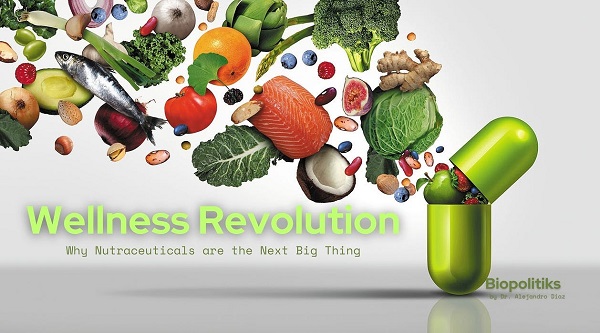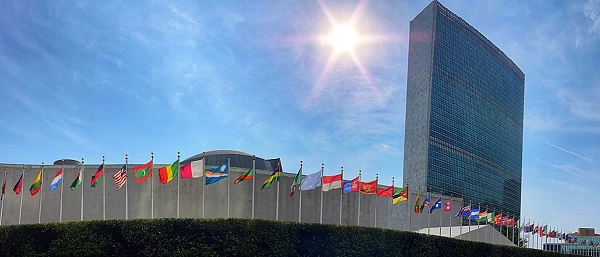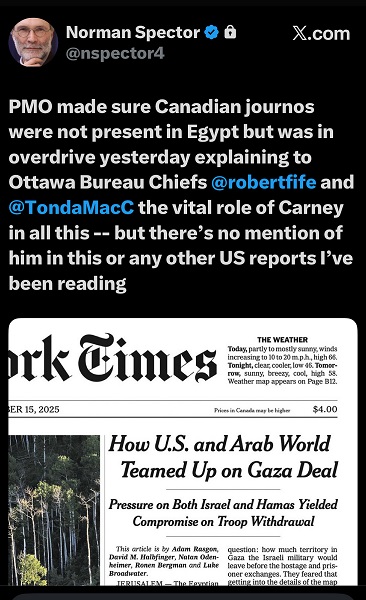Health
Wellness Revolution

|
|
From Courageous Discourse
Why Nutraceuticals are the Next Big Thing
The New Health Conscious
The revival of health consciousness that has taken place in this decade has changed the way the general public views healthcare—forever. The COVID Operation put health back into the conversation. This elevation in the collective health consciousness has led to a Wellness Revolution, worldwide.
Patients now understand the reality of the state of healthcare systems. The fact is that we are a highly medicated and highly vaccinated society, and the truth is that as the use of these products has increased, so has disease prevalence.
If we take more vaccines and more medications than ever before as a society, shouldn’t we be healthier than ever? Unfortunately, this isn’t the case. The global population is sick and only getting sicker; the toxic injectable products, gene therapy, so-called “COVID Vaccines” made sure that people become permanent clients of the sick-care industrial complex.
A stellar example of this phenomenon is the United States. The United States makes up around 4% of the world’s population, yet it represents around 64 to 78 percent of global pharmaceutical profits. This should mean that Americans are the healthiest in the world by far, right? Unfortunately, no. The United States leads the world in chronic disease prevalence and has a significantly lower life expectancy than most other developed nations.
The current system is fraudulent. People are taking notice of this fraud. In protest, they are looking for alternatives to traditional medicines for disease care. One of the emerging therapeutics in this realm is nutraceuticals.
Nutraceuticals are foods or elements of food obtained from plant or animal origin with significant medical or health benefits utilized to prevent or cure diseases. The medicinal use of food or food elements derives from the beginning of modern medical understanding. Hippocrates is famous for his remarks on this issue. He states, “Let food be thy medicine and medicine be thy food.”
As an allopath (Pediatric Allergist/Immunologist), I increasingly shift towards this alternative line of thinking. I am not saying that all medications are bad, but I think we have to be far more selective in the way we use them.
Recently the term “nutraceuticals” has regained relevance. Once brushed off by the medical community as fringe “pseudoscience” with no demonstrated clinical benefits, is now being lauded at the highest levels of healthcare policy. In a controversial tweet, just before the U.S. Presidential Election, Robert F. Kennedy Jr. shared some details of his plans for public health in the United States.
I have repeatedly mentioned the significance of Robert F. Kennedy Jr.’s appointment to lead the Department of Health and Human Services. His appointment assures that the official narratives on alternative approaches will change from a tone of “aggressive suppression” as RFK describes it, to one of medical freedom. This will surely accelerate the effects of the wellness revolution.
The Wellness Revolution
This movement represents a change in the public’s attitudes toward their health. This has materialized in several different ways. First, it is in the products that patients choose to consume. Pharma, for example, has taken advantage of this wellness attitude shift by introducing products such as GLP-1s, statins, and other drugs to remediate the effects of the chronic disease epidemic that they caused. Additionally, it’s very common to see these drugs cause side effects, forcing patients to take yet another pill to “alleviate” the adverse effects, resulting in a never-ending vicious cycle.
It all boils down to a social movement that emphasizes disease prevention and longevity. The medical device industry has seen an explosion of growth for these reasons. Particularly wearable medical devices such as health trackers. These functional health trends are transforming patient care.
Probably the most significant way that this wellness revolution is materializing is in terms of diet and nutrition. The dietary supplement and nutrition industry has seen an explosion in growth over the last couple of decades, and with growing demand due to distrust and disillusion with traditional pharma and medical systems, this growth is set to continue. But even in nutrition, we have to regulate how they treat the source with pesticides and fertilizers, etc.
The term “nutraceuticals” is relatively new but has gained rapid relevance in alternative medical spaces. Although the term encompasses a broad umbrella of elements, essentially it refers to natural food products or components found in food that can be utilized for medicinal purposes. This can include components such as prebiotics, probiotics, vitamins, fibers, etc.
This functional approach to health is what will take the medical profession into the future. At the end of the day, these methods are in the best interest of the patient.
The microbiome is another example. A new world of information that explains how bifidobacteria interact and regulate many bodily functions. Dr. Sabine Hazan, an expert in the field, has talked extensively about this issue in her book “Let’s Talk SH!T”, a must-read.
Functional foods and nutraceuticals will be the base of treatment in the foreseeable future. These compounds provide health benefits beyond basic nutrition and contain bioactive compounds that can affect the body in various ways. for example, reduce cholesterol levels and inflammation, including examples such as fermented foods like miso, kimchi, flax seeds, salmon, omega-3 fatty acids, and walnuts. While compounds such as probiotics promote gut microbiota balance, which is crucial for immunity and digestion.
The immense majority of diseases have one common denominator: Inflammation. Considering how functional foods and nutraceuticals have inflammation-reducing benefits, these products can have an extensive range of applications.
I would like to provide a couple of examples of bioactive compounds that have medicinal benefits. Turmeric and Curcumin, for example, have anti-inflammatory, and antioxidant benefits and may also contribute to remediating the effects of heart disease, Alzheimer’s disease, and depression. Some even cite turmeric’s potential to inhibit cancer progression.
What the shift to these products also represents is an emphasis on prevention. Increased clinical use of these types of natural products will promote a culture of disease prevention rather than disease management.
Robert F. Kennedy Jr. was asked in an interview recently with CNBC’s Jim Cramer about his thoughts on GLP-1s. RFK Jr. responded by saying “The first line of response should be lifestyle. It should be eating well—making sure you don’t get obese…”
This represents a fundamental shift in the line of thinking in those leading public health policy. I have never heard anyone in government speak that way.
The ideological change that is set to take place as the new administration takes power will surely flow downstream to medical standards of care, further exacerbating the growth in the market of natural remedies, including nutraceuticals.
I fully support this change. For too long, patients and even doctors have been attacked on all fronts, forcing them to cave to the status quo or face excommunication from the medical religion. If we are sincere, medicine is a religion. Dr. Robert Mendelsohn touches on this topic in his book “Confessions of a Medical Heretic”.
Physicians from all medical orthodoxies, whether they be allopathic, homeopathic, osteopathic, or naturopathic, should unite in consensus about the healing effects of these compounds and their applications in treating and managing disease.
A shift away from over-medication is necessary to reverse the effects of the chronic disease epidemic and the long-term promotion of optimal health.
Nutraceuticals: Bridging the Gap between Nutrition and Medicine. This emerging field has become a cornerstone in the shift towards preventive healthcare, where the focus is not only on treating illness but also on sustaining optimal health. A new awareness in the field of medicine is on the rise, as physicians, we have to be loyal to our Hippocratic oath “Primum non nocere”. In modern medicine, praxis physicians rarely ask the patient about the quality of their sleep, the basis of their diet, and the patient’s social environment.
I’m excited to see what the future holds for this momentous awakening.
FIN
Biopolitiks by Dr. Alejandro Diaz
Share and subscribe for critical insights on how health and politics shape our world. Join a growing community working to redefine the future of healthcare and governance.
Health
New report warns WHO health rules erode Canada’s democracy and Charter rights

The Justice Centre for Constitutional Freedoms has released a new report titled Canada’s Surrender of Sovereignty: New WHO health regulations undermine Canadian democracy and Charter freedoms. Authored by Nigel Hannaford, a veteran journalist and researcher, the report warns that Canada’s acceptance of the World Health Organization’s (WHO) revised International Health Regulations (IHR) represents a serious erosion of national independence and democratic accountability.
The IHR amendments, which took effect on September 19, 2025, authorize the WHO Director-General to declare global “health emergencies” that could require Canada to follow directives from bureaucrats in Geneva, bypassing the House of Commons and the will of Canadian voters.
The WHO regards these regulations as “binding,” despite having no ability or legal authority to impose such regulations. Even so, Canada is opting to accept the regulations as binding.
By accepting the WHO’s revised IHR, the report explains, Canada has relinquished its own control over future health crises and instead has agreed to let the WHO determine when a “pandemic emergency” exists and what Canada must do to respond to it, after which Canada must report back to the WHO.
In fact, under these International Health Regulations, the WHO could demand countries like Canada impose stringent freedom-violating health policies, such as lockdowns, vaccine mandates, or travel restrictions without debate, evidence review, or public accountability, the report explains.
Once the WHO declares a “Pandemic Emergency,” member states are obligated to implement such emergency measures “without delay” for a minimum of three months.
Importantly, following these WHO directives would undermine government accountability as politicians may hide behind international “commitments” to justify their actions as “simply following international rules,” the report warns.
Canada should instead withdraw from the revised IHR, following the example of countries like Germany, Austria, Italy, Czech Republic, and the United States. The report recommends continued international cooperation without surrendering control over domestic health policies.
Constitutional lawyer Allison Pejovic said, “[b]y treating WHO edicts as binding, the federal government has effectively placed Canadian sovereignty on loan to an unelected international body.”
“Such directives, if enforced, would likely violate Canadians’ Charter rights and freedoms,” she added.
Mr. Hannaford agreed, saying, “Canada’s health policies must be made in Canada. No free and democratic nation should outsource its emergency powers to unelected bureaucrats in Geneva.”
The Justice Centre urges Canadians to contact their Members of Parliament and demand they support withdrawing from the revised IHR to restore Canadian sovereignty and reject blind compliance with WHO directives.
Business
Cutting Red Tape Could Help Solve Canada’s Doctor Crisis

From the Frontier Centre for Public Policy
By Ian Madsen
Doctors waste millions of hours on useless admin. It’s enough to end Canada’s doctor shortage. Ian Madsen says slashing red tape, not just recruiting, is the fastest fix for the clogged system.
Doctors spend more time on paperwork than on patients and that’s fueling Canada’s health care wait lists
Canada doesn’t just lack doctors—it squanders the ones it has. Mountains of paperwork and pointless admin chew up tens of millions of physician hours every year, time that could erase the so-called shortage and slash wait lists if freed for patient care.
Recruiting more doctors helps, but the fastest cure for our sick system is cutting the bureaucracy that strangles the ones already here.
The Canadian Medical Association found that unnecessary non-patient work consumes millions of hours annually. That’s the equivalent of 50.5 million patient visits, enough to give every Canadian at least one appointment and likely erase the physician shortage. Meanwhile, the Canadian Institute for Health Information estimates more than six million Canadians don’t even have a family doctor. That’s roughly one in six of us.
And it’s not just patients who feel the shortage—doctors themselves are paying the price. Endless forms don’t just waste time; they drive doctors out of the profession. Burned out and frustrated, many cut their hours or leave entirely. And the foreign doctors that health authorities are trying to recruit? They might think twice once they discover how much time Canadian physicians spend on paperwork that adds nothing to patient care.
But freeing doctors from forms isn’t as simple as shredding them. Someone has to build systems that reduce, rather than add to, the workload. And that’s where things get tricky. Trimming red tape usually means more Information Technology (IT), and big software projects have a well-earned reputation for spiralling in cost.
Bent Flyvbjerg, the global guru of project disasters, and his colleagues examined more than 5,000 IT projects in a 2022 study. They found outcomes didn’t follow a neat bell curve but a “power-law” distribution, meaning costs don’t just rise steadily, they explode in a fat tail of nasty surprises as variables multiply.
Oxford University and McKinsey offered equally bleak news. Their joint study concluded: “On average, large IT projects run 45 per cent over budget and seven per cent over time while delivering 56 per cent less value than predicted.” If that sounds familiar, it should. Canada’s Phoenix federal payroll fiasco—the payroll software introduced by Ottawa that left tens of thousands of federal workers underpaid or unpaid—is a cautionary tale etched into the national memory.
The lesson isn’t to avoid technology, but to get it right. Canada can’t sidestep the digital route. The question is whether we adapt what others have built or design our own. One option is borrowing from the U.S. or U.K., where electronic health record (EHR) systems (the digital patient files used by doctors and hospitals) are already in place. Both countries have had headaches with their systems, thanks to legal and regulatory differences. But there are signs of progress.
The U.K. is experimenting with artificial intelligence to lighten the administrative load, and a joint U.K.-U.S. study gives a glimpse of what’s possible:
“… AI technologies such as Robotic Process Automation (RPA), predictive analytics, and Natural Language Processing (NLP) are transforming health care administration. RPA and AI-driven software applications are revolutionizing health care administration by automating routine tasks such as appointment scheduling, billing, and documentation. By handling repetitive, rule-based tasks with speed and accuracy, these technologies minimize errors, reduce administrative burden, and enhance overall operational efficiency.”
For patients, that could mean fewer missed referrals, faster follow-up calls and less time waiting for paperwork to clear before treatment. Still, even the best tools come with limits. Systems differ, and customization will drive up costs. But medicine is medicine, and AI tools can bridge more gaps than you might think.
Run the math. If each “freed” patient visit is worth just $20—a conservative figure for the value of a basic appointment—the payoff could hit $1 billion in a single year.
Updating costs would continue, but that’s still cheap compared to the human and financial toll of endless wait lists. Cost-sharing between provinces, Ottawa, municipalities and even doctors themselves could spread the risk. Competitive bidding, with honest budgets and realistic timelines, is non-negotiable if we want to dodge another Phoenix-sized fiasco.
The alternative—clinging to our current dysfunctional patchwork of physician information systems—isn’t really an option. It means more frustrated doctors walking away, fewer new ones coming in, and Canadians left to languish on wait lists that grow ever longer.
And that’s not health care—it’s managed decline.
Ian Madsen is a senior policy analyst at the Frontier Centre for Public Policy.
-

 Alberta24 hours ago
Alberta24 hours agoClick here to help choose Alberta’s new licence plate design
-

 National1 day ago
National1 day agoDemocracy Watch Renews Push for Independent Prosecutor in SNC-Lavalin Case
-

 Business1 day ago
Business1 day agoOver two thirds of Canadians say Ottawa should reduce size of federal bureaucracy
-

 Business2 days ago
Business2 days agoTrump Admin Blows Up UN ‘Global Green New Scam’ Tax Push, Forcing Pullback
-

 Business2 days ago
Business2 days agoTrump Blocks UN’s Back Door Carbon Tax
-

 Media1 day ago
Media1 day agoCanada’s top Parliamentary reporters easily manipulated by the PMO’s “anonymous sources”
-

 Agriculture1 day ago
Agriculture1 day agoIs the CFIA a Rogue Agency or Just Taking Orders from a Rogue Federal Government?
-

 espionage1 day ago
espionage1 day ago“Suitcase of Cash” and Secret Meeting Deepen Britain’s Beijing Espionage Crisis








